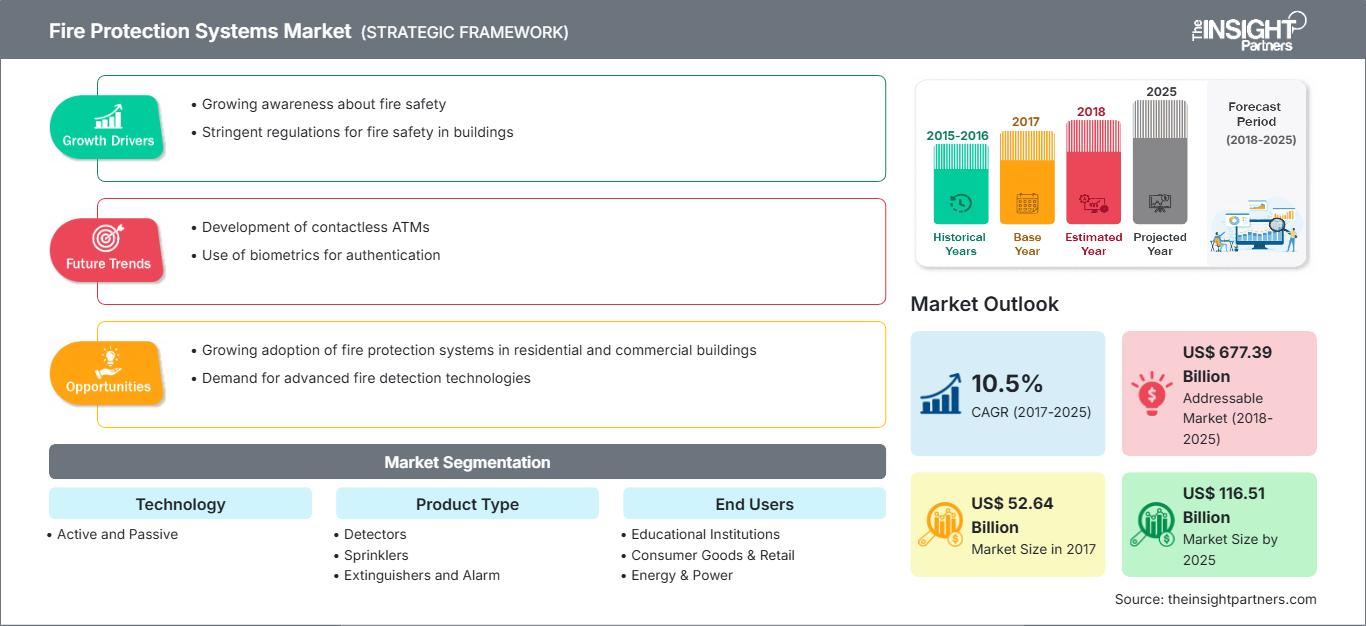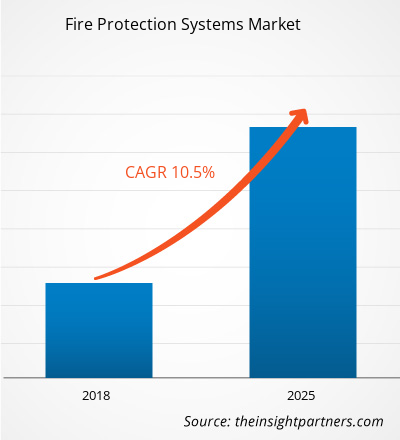Le marché des systèmes de protection incendie a représenté 52,64 milliards de dollars américains en 2017 et devrait croître à un TCAC de 10,5 % au cours de la période de prévision 2018-2025, pour atteindre 116,51 milliards de dollars américains d'ici 2025.
La croissance des cinq dernières années est principalement tirée par deux facteurs majeurs : le besoin d'un système de protection incendie sûr et efficace à l'intérieur des bâtiments en raison de l'urbanisation croissante, et la nécessité de respecter les normes et réglementations strictes en matière d'incendie.Le marché mondial des systèmes de protection incendie connaît actuellement une croissance constante et devrait croître dans les années à venir. Il est composé d'acteurs bien établis à travers le monde, qui investissent des sommes considérables afin de fournir la technologie la plus avancée à leurs clients. Les avionneurs, quant à eux, s'approvisionnent en technologies de pointe auprès des fabricants de composants aéronautiques pour offrir aux passagers des services à valeur ajoutée supplémentaires et ainsi leur offrir une expérience de voyage supérieure. Ce facteur contribue à la croissance du marché des systèmes de protection incendie au cours de la période.
Personnalisez ce rapport en fonction de vos besoins
Vous bénéficierez d’une personnalisation sur n’importe quel rapport - gratuitement - y compris des parties de ce rapport, ou une analyse au niveau du pays, un pack de données Excel, ainsi que de profiter d’offres exceptionnelles et de réductions pour les start-ups et les universités
Marché des systèmes de protection incendie: Perspectives stratégiques

- Obtenez les principales tendances clés du marché de ce rapport.Cet échantillon GRATUIT comprendra une analyse de données, allant des tendances du marché aux estimations et prévisions.
Aperçu du marché des systèmes de protection incendie : Nécessité d'un système de protection incendie sûr et efficace à l'intérieur des bâtiments en raison de l'urbanisation croissante
Vous bénéficierez d’une personnalisation sur n’importe quel rapport - gratuitement - y compris des parties de ce rapport, ou une analyse au niveau du pays, un pack de données Excel, ainsi que de profiter d’offres exceptionnelles et de réductions pour les start-ups et les universités
Marché des systèmes de protection incendie: Perspectives stratégiques

- Obtenez les principales tendances clés du marché de ce rapport.Cet échantillon GRATUIT comprendra une analyse de données, allant des tendances du marché aux estimations et prévisions.
Le 21e siècle a été témoin d'un afflux massif de population dans les villes des économies développées et en développement à la recherche d'une vie meilleure. Des niveaux de vie plus élevés, de meilleures opportunités d'emploi, l'accès à des équipements et services modernes sont les quelques facteurs majeurs qui ont contribué à la migration de la population rurale vers les zones urbaines du monde entier. Les économies en développement ont connu une croissance régulière après la récession, ce qui a entraîné une augmentation des revenus disponibles des consommateurs. Selon les données de la Banque mondiale, actuellement 54 % de la population mondiale réside dans les zones urbaines, tandis que les pourcentages restants résident toujours dans les zones rurales. Ainsi, près de 4 milliards de la population mondiale vivent dans les zones urbaines, ce qui exerce une pression accrue sur les infrastructures des zones urbaines. En conséquence, la densité de population dans ces zones a atteint des niveaux sans précédent.
Ainsi, la nécessité d'un système de protection incendie robuste pour être prêt à gérer toute situation critique et éviter les pertes dues au feu est évidente. Ainsi, la demande pour un système de protection incendie plus sûr, efficace et à réponse plus rapide a stimulé le marché des systèmes de protection incendie ces derniers temps.
Nécessité de respecter les normes et réglementations strictes en matière d'incendie
La majorité des économies avancées et en développement ont établi des réglementations strictes en matière d'incendie concernant la construction de nouveaux bâtiments afin de garantir la sécurité des occupants. Des pays comme l'Amérique du Nord, l'Australie, le Canada, le Mexique, le Royaume-Uni, l'Allemagne, l'Espagne, l'Italie et l'Inde ont établi des réglementations strictes. De plus, les autorités compétentes ont prévu de lourdes sanctions en cas de non-respect des codes. Pratiquement tous les bâtiments, processus, services, conceptions et installations sont concernés par les codes et normes de la NFPA. Ces codes et normes reflètent l'évolution des besoins de l'industrie et des technologies, soutenus par la recherche et le développement, et l'expérience pratique. Français L'établissement de telles règles et réglementations a stimulé l'adoption du marché des systèmes de protection incendie à l'échelle mondiale.
Quelques-unes des stratégies récentes de certains des acteurs du paysage du marché des systèmes de protection incendie sont énumérées ci-dessous :
2018 : La branche sud du Musée national du Palais, située à (Taïwan), a installé le système d'alarme incendie Notifier de Honeywell, afin de fournir une intégration système avec des coûts d'exploitation minimaux et de faciliter la personnalisation en fonction des besoins futurs du musée. Le système Notifier est associé à un autre système pour faciliter les évacuations en émettant un signal sonore différent. 2018 : Siemens AG travaille avec Skanska Walsh dans le cadre d'une coentreprise pour installer la solution d'infrastructure intelligente Siemens dans le nouveau complexe du terminal central de l'aéroport international de LaGuardia (États-Unis). La solution intelligente comprend un système de sécurité incendie et de sécurité des personnes et une automatisation intégrée des bâtiments. 2018 : Viking a annoncé son projet de nouveaux centres de R&D et de siège social à Caledonia Township, dans l'ouest du Michigan. Cette expansion créera des compétences de formation de haute technologie pour soutenir l'objectif de l'organisation de maintenir sa position de leader dans les services de protection incendie.
Aperçu régional du marché des systèmes de protection incendie
Les tendances régionales et les facteurs influençant le marché des systèmes de protection incendie tout au long de la période de prévision ont été analysés en détail par les analystes de The Insight Partners. Cette section aborde également les segments et la géographie du marché des systèmes de protection incendie en Amérique du Nord, en Europe, en Asie-Pacifique, au Moyen-Orient et en Afrique, ainsi qu'en Amérique du Sud et en Amérique centrale.
Portée du rapport sur le marché des systèmes de protection incendie
| Attribut de rapport | Détails |
|---|---|
| Taille du marché en 2017 | US$ 52.64 Billion |
| Taille du marché par 2025 | US$ 116.51 Billion |
| TCAC mondial (2017 - 2025) | 10.5% |
| Données historiques | 2015-2016 |
| Période de prévision | 2018-2025 |
| Segments couverts |
By Technologie
|
| Régions et pays couverts | Amérique du Nord
|
| Leaders du marché et profils d'entreprises clés |
|
Densité des acteurs du marché des systèmes de protection incendie : comprendre son impact sur la dynamique des entreprises
Le marché des systèmes de protection incendie connaît une croissance rapide, portée par une demande croissante des utilisateurs finaux, due à des facteurs tels que l'évolution des préférences des consommateurs, les avancées technologiques et une meilleure connaissance des avantages du produit. Face à cette demande croissante, les entreprises élargissent leur offre, innovent pour répondre aux besoins des consommateurs et capitalisent sur les nouvelles tendances, ce qui alimente la croissance du marché.

- Obtenez le Marché des systèmes de protection incendie Aperçu des principaux acteurs clés
- Analyse historique (2 ans), année de base, prévision (7 ans) avec TCAC
- Analyse PEST et SWOT
- Taille du marché Valeur / Volume - Mondial, Régional, Pays
- Industrie et paysage concurrentiel
- Ensemble de données Excel
Rapports récents
Témoignages
Raison d'acheter
- Prise de décision éclairée
- Compréhension de la dynamique du marché
- Analyse concurrentielle
- Connaissances clients
- Prévisions de marché
- Atténuation des risques
- Planification stratégique
- Justification des investissements
- Identification des marchés émergents
- Amélioration des stratégies marketing
- Amélioration de l'efficacité opérationnelle
- Alignement sur les tendances réglementaires






















 Obtenez un échantillon gratuit pour - Marché des systèmes de protection incendie
Obtenez un échantillon gratuit pour - Marché des systèmes de protection incendie